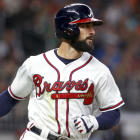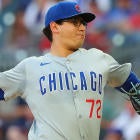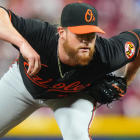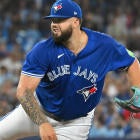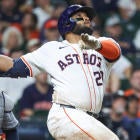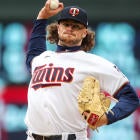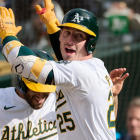More Fantasy Baseball: Prioritizing 16 of most exciting pitchers to emerge on waiver wire
By now, we should know who Nick Markakis is.
The 34-year-old is in his 13th year in the majors and fourth year with his present club. And while his career began with great promise -- four years of must-start production, basically -- he ultimately slid into mediocrity, becoming a capable fill-in when the matchups were right but nothing more.
Entering play Monday, though, he was leading the NL in both batting average (.344) and hits (45). He was on a 29-homer, 123-RBI, 103-run pace, ranking fifth among outfielders in Head-to-Head points leagues and 10th in Rotisserie.
- Subscribe to the Fantasy Baseball Today podcast for free on Apple Podcasts, Stitcher, TuneIn, Google Play or anywhere else you listen.
But we should know better, right?
Maybe we should, but the temptation to play the hot hand is especially great when he's known to have a high floor. One area where Markakis has always excelled is plate discipline. He makes consistent contact. He gets on base at an above-average rate. So while his production is historically boring, it's also the epitome of safe. He's not going to bury you, which is a quality so many Fantasy owners would welcome right about now.
And it just so happens that safe has a way of becoming not so boring with the right supporting cast. Just look at DJ LeMahieu.
So just like that, a player who was only 12 percent owned at the start of the season, when everybody purportedly knew who he was, is now 91 percent owned. And he's not alone. Nearly a quarter of the way into 2018, six older hitters who were presumed to be bottom-feeders in Fantasy, with no hope for anything more, have instead emerged as lineup fixtures.
But is it a waste of time? Shouldn't we know better?
I'll examine them one by one and assign a legitimeter rating of 1-5, with one being the least legit and five being the most legit.
Mostly, I'm saying the Braves' unexpectedly stout lineup is helping Markakis' skills play up, which is primarily reflected in the RBI and run totals. If you look back through his history, his contributions in those two categories were a big reason why he was considered more of an asset in his first four years with the Orioles. The Braves have always liked batting him in an RBI spot, relying on his contact rate to extend rallies, but now more men are on base in front of him with more to drive him in as well.
He's doing some new things on his own, too. Yes, his .344 batting average is built on a high BABIP, but not crazy-high. At .345, it's just a little above last year's .324 mark. He actually had a .338 BABIP in his first year with the Braves. No, the biggest change is that he has cut his already favorable strikeout rate in half. And even if 8.6 percent is too good to last, I foresee only a gentle correction for both it and the BABIP.
Bottom line is you don't have to squint too hard to see him hitting .300. And if, as his reduced ground-ball rate suggests, he comes closer to being a 15-homer guy than the eight-homer guy he was last year, in this lineup, you may find it surprisingly hard to remove him from yours, particularly in a points league.
From one Brave to another, Kurt Suzuki actually made the sort of change I was hoping to see from Markakis last year. But of course, few gave it much credence, citing his uninspiring track record, and it didn't help that he was splitting at-bats with Tyler Flowers.
But a quarter of the way into this season, he's up the same old tricks -- doing it even better, actually, because like Markakis, he has cut his already favorable strikeout rate in half. What matters even more, though, are the power gains, and with those carrying over completely, I'm not sure what reason anyone would have to doubt Suzuki anymore.
The return of Flowers from an oblique injury has cut into Suzuki's playing time a bit, which is why he's only a four on the legitimeter. But he's still likely to get 60 percent of the starts behind the plate, which is fairly typical among catchers. As one with plus contact ability and plus power, he's s strong bet to finish in the top 12.
It's fair to argue Asdrubal Cabrera was underrated at the start of the year, when he was drafted in only 40 percent of CBS Sports leagues despite his triple eligibility. But what the 32-year-old is doing now is unlike anything he has done before -- in ways that are mostly unsustainable.
His .368 BABIP would be too good to be true for most any hitter, but it's especially out of character for him. The last time his was higher than .310 was in 2010 for the Indians, and even then, it was .318. His .244 ISO, a measure of pure power, is 50 points above his career high -- and without drastic changes to his fly-ball and hard-contact rates.
Cabrera's batted-ball profile looks much like the one he had in 2016, when he hit .280 with 23 home runs -- a respectable season, no doubt, particularly for a player with middle infield eligibility. But that's probably as good as it gets for him and is too far off his current pace for me to classify him as anything other than a sell-high, especially since you'll need to factor in a DL stint at some point.
One of several players who reportedly changed his launch angle this offseason in the interest of generating more fly balls, Francisco Cervelli has followed through on it in a way few others have, going from about a 26 percent rate in his first three years with the Pirates to a 49.3 percent rate this year. And the impact on his power is as you'd expect. He has hit as many home runs as a year ago in only about one-third of the action, and his .559 slugging percentage leads all full-time catchers.
Whether he can sustain quite those gains remains to be seen, but the fact is he's a different hitter now -- and in the best possible ways given what we know works in today's MLB. And seeing as Cervelli always had exemplary plate discipline, it would take only moderate power gains for him to become what Jonathan Lucroy was in his prime.
I consider him a top-10 catcher moving forward.
First, you should know Jed Lowrie was underrated to begin with. Even with the numbers he put together last year -- a paltry .277 batting average 14 home runs and .808 OPS -- he was the No. 10 second baseman in Head-to-Head points leagues and No. 21 in Rotisserie, so the fact he was drafted in only 20 percent of CBS Sports leagues was fairly silly.
But it also reflected our reluctance to pay for the upside of a player who has been notoriously inconsistent and injury-prone -- upside I would say hasn't actually changed despite Lowrie's production so far.
Where should I start? The walk rate is down. The contact rate is down. The fly-ball rate is down. The line-drive rate is down. Most every indicator of what might make a hitter better in ways he can actually sustain is down from where it was a year ago. So what's up? His BABIP, an outlandish .400, and his home run-to-fly ball, an outlandish 20.0 percent.
I assign Lowrie a one on the legitimeter not because he's worthless -- he may well be who he was last year -- but because I'm fully convinced he's nowhere this good.
Kevin Pillar has a lot of the same issues as Lowrie, namely the high BABIP (but not as high) and reduced fly-ball rate. But the line-drive rate is way up and the quality of contact also drastically better. How meaningful are those particular measures at this stage of the season? I'd say we're more likely to see correction than not, but I'm also giving him at least a chance of living up to his potential as a plus batting average guy, something his contact rate and foot speed have always suggested he should be.
Speaking of foot speed, that's the biggest reason I'm giving Pillar a three on the legitimeter. We know he can run -- he's one of the best defensive center fielders in the game -- but rarely does he demonstrate those skills on the base paths. So far this year, though, he's 6 for 6 in stolen bases, putting him on a 28-steal pace.
Now, three of those came in one inning against Dellin Betances back on March 31, but he already has two in May. With every success, the confidence builds a little, and I suspect Pillar becomes all the more likely to attempt another. He was a 25-steal guy in 2015, after all.
In today's environment, with so few stolen bases to go around, it almost doesn't matter what Pillar does at the plate if he's pushing for 30 steals. I'd want to hang on a little longer to see where it goes if that category was of great import to me.






















